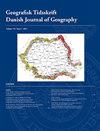二级城市的空间和社会转型:加纳Sekondi-Takoradi城市流动性的作用
IF 1.1
4区 社会学
Q4 ENVIRONMENTAL STUDIES
Geografisk Tidsskrift-Danish Journal of Geography
Pub Date : 2017-06-28
DOI:10.1080/00167223.2017.1343672
引用次数: 20
摘要
关于加纳城市的现有研究主要集中在该国主要城市内部发生的过程,从而再现了社会科学内部忽视中级和二级城市作用的趋势。本文旨在通过探索Sekondi-Takoradi的空间和社会转型来解决这一缺陷,Sekondi-Takoradi是加纳的二级城市之一,也是服务于该地区新兴橡胶工业以及该国石油和天然气经济的大都市区。通过对城市五个社区的居民进行定性访谈,以及对考夫曼流动性类型学的修改版本,我们研究了向Sekondi-Takoradi的迁移、城市内的住宅流动性和城市居民的日常流动性。本文强调了这些不同形式的流动如何与Sekondi-Takoradi内外发生的进程相互作用,最显著的是影响和被生计战略影响。有人认为,城市及其腹地最好被设想为一个移动的网络整体,而不是由不相连和分隔的区域组成。因此,本文通过提供有关非洲二线城市发展事件的新经验数据,有助于就流动性如何影响城市化展开更广泛的辩论,并通过提供对城市及其周边农村地区分别进行考察的文献的反叙述,扩展了现有的研究。本文章由计算机程序翻译,如有差异,请以英文原文为准。
Spatial and social transformations in a secondary city: the role of mobility in Sekondi-Takoradi, Ghana
Abstract Existing research on urban Ghana mainly focuses on processes occurring within the country’s major cities, thereby reproducing a trend within the social sciences to overlook the role of intermediate and secondary cities. This paper aims to address this shortcoming by exploring spatial and social transformations in Sekondi–Takoradi, one of Ghana’s secondary cities and the metropolitan area serving the region’s emerging rubber industries as well as the country’s oil and gas economy. Using qualitative interviews conducted with residents in five of the city’s neighbourhoods, and a modified version of Kaufmann’s typology of mobility, we examine migration into Sekondi–Takoradi, residential mobility within the city and the daily mobility of the city’s residents. The paper highlights how these diverse forms of mobility interact with processes taking place both within and outside Sekondi–Takoradi, most notably influencing and being influenced by livelihood strategies. It is argued that the city and its hinterlands can best be envisaged as a mobile networked whole, rather than consisting of disconnected and compartmentalized locales. The paper thus contributes to broader debates on how mobility shapes urbanization by providing new empirical data on events unfolding in Africa’s secondary cities, and extends existing research by providing a counter-narrative to literature that examines the city and its surrounding rural areas separately.
求助全文
通过发布文献求助,成功后即可免费获取论文全文。
去求助
来源期刊
CiteScore
5.20
自引率
0.00%
发文量
5
期刊介绍:
DJG is an interdisciplinary, international journal that publishes peer reviewed research articles on all aspects of geography. Coverage includes such topics as human geography, physical geography, human-environment interactions, Earth Observation, and Geographical Information Science. DJG also welcomes articles which address geographical perspectives of e.g. environmental studies, development studies, planning, landscape ecology and sustainability science. In addition to full-length papers, DJG publishes research notes. The journal has two annual issues. Authors from all parts of the world working within geography or related fields are invited to publish their research in the journal.

 求助内容:
求助内容: 应助结果提醒方式:
应助结果提醒方式:


